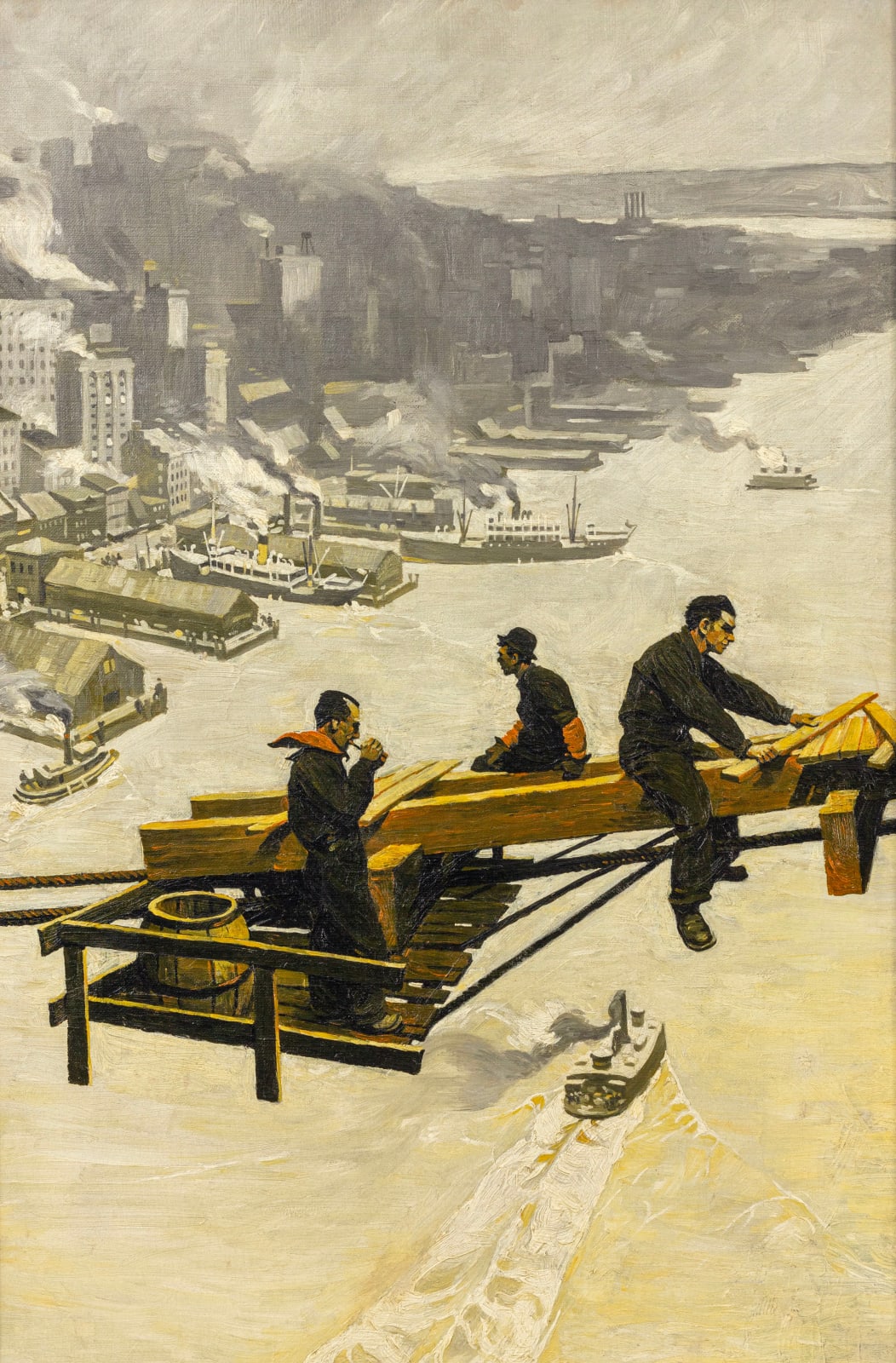Thornton Oakley
69.2 x 45.7 cm
For Thornton Oakley, the illustrator’s art was the noblest of artistic ambitions; he believed it had the power to convey human virtue with the utmost clarity. Oakley was a child of a golden age, an age of wonder, and it was illustrators for the lavish weeklies and monthlies, like Harper’s and Century, who offered vivid interpretations of every spectacular achievement of the day, from visionary architecture to bridge building. He grew up admiring the magazine art of Howard Pyle, Edwin Austen Abbey, and Joseph Pennell, and though he trained initially as an architect at the University of Pennsylvania, Oakley directed his enthusiasm for the building arts toward illustration. He entered under the tutelage of the esteemed Pyle and joined the ranks of the exceptional illustrators who emerged from Pyle’s Wilmington, Delaware studio, Newell Convers Wyeth among them. [1]
Oakley was in thrall to the modern age of invention. He was the favored artist for depicting the Herculean efforts of mere men to “control matter,” as he put it, to dig and build as never before in a quest to conquer nature’s limitations on human progress. [2] He was the obvious choice for the series that would illustrate writer Edward Hungerford’s poetic paean to the modern bridge as a great civilizing force, a “weaver” of once isolated communities into a great collective force of humanity, and a construct that made “weavers” of modern men who would spin and hang the steel cables. His subject was the Manhattan Bridge, a new suspension structure over the East River. [3]
For Hungerford’s piece in Harper’s Monthly, Oakley painted the heroics of men who laid the caissons (there is no feat harder “in the weaving of the bridge,” Hungerford wrote) and raised the beams that would support the cables. [4] This particular feat of modern bridge building, the Manhattan Bridge, was being well documented in photographs, and Oakley had a wealth of material to draw upon to inform his own observations at the various sites. His most dramatic composition from the group is this vertiginous view of fearless men who seem to float, untethered and nonchalantly, high above the water below as they work to construct the long narrow footpaths across the temporary cables that will carry the men who will weave the sustaining fabric of the bridge. They were the showmen of the of the crew, Hungerford said of them, delighting in the attention that
their daring attracted.
Oakley’s illustrations for “The Weaving of the Bridge” were to appear “in tint” in Harper’s Monthly, and he painted them in oil. [5] He had been taught by Pyle to think of his subjects in terms of color and the full range of darks and lights, and so oil was the preferred medium of the Pyle school for the most elaborate work. In this case, color is essential to establishing the vast distance between the vague gray smoky cityscape and river far below and the living, breathing men who fill the foreground.
— Patricia Junker
[1] Oakley laid out his philosophy in a long review of the illustrators he admired; see Thornton Oakley “Remarks on Illustration and Pennsylvania’s Contributors to Its Golden Age,” Pennsylvania Magazine of History and Biography 71, no. 1 (January 1947): 3–18.
[2] Oakley, 9.
[3] Edward Hungerford, “”The Weaving of the Bridge,” Harper’s Monthly Magazine, June 1909, 221–32.
[4] Hungerford, 224.
[5] The term is applied to Oakley’s illustrations in the Table of Contents to the issue.
Provenance
The artist;[Sale: Christie’s, New York, March 16, 1990, lot 292];
The present owner
Exhibitions
Schoelkopf Gallery, New York, American Stories: The Kathleen Kennedy and Frank Marshall Collection, January 17—February 28, 2025Literature
Edward Hungerford, “The Weaving of the Bridge,” Harper’s Monthly Magazine, July 1909, p. 223 illus.Joyce K. Schiller, Rockwell Center for American Visual Studies, "Skyscraper Construction," Norman Rockwell Museum, 2012, illus., Accessed September 25, 2024
Claire Ittner, Patricia Junker, and Carol Troyen, American Stories: The Kathleen Kennedy and Frank Marshall Collection, New York: Schoelkopf Gallery, 2025
Subscribe to our mailing list to receive updates from the gallery
* denotes required fields
We will process the personal data you have supplied in accordance with our privacy policy (available on request). You can unsubscribe or change your preferences at any time by clicking the link in our emails.

